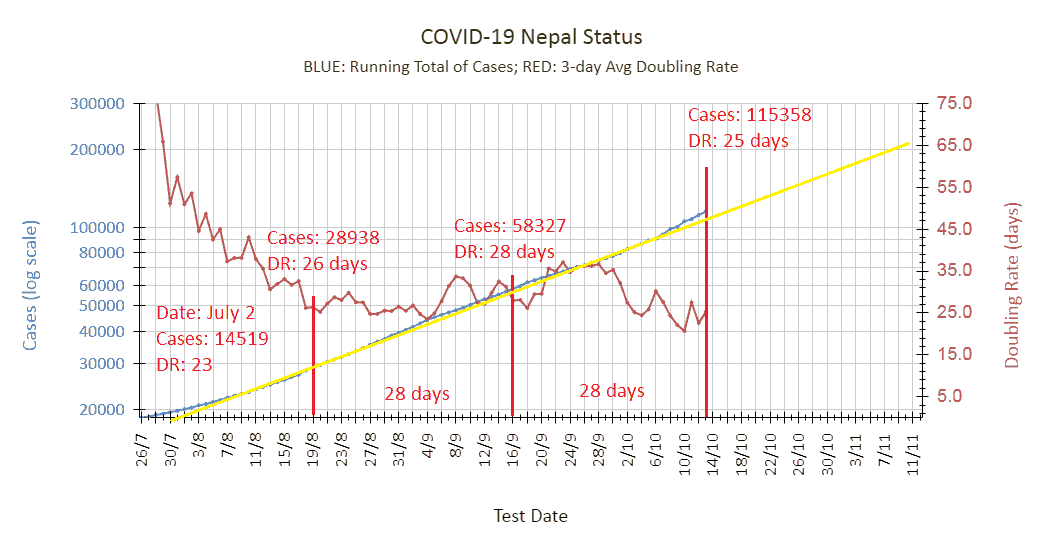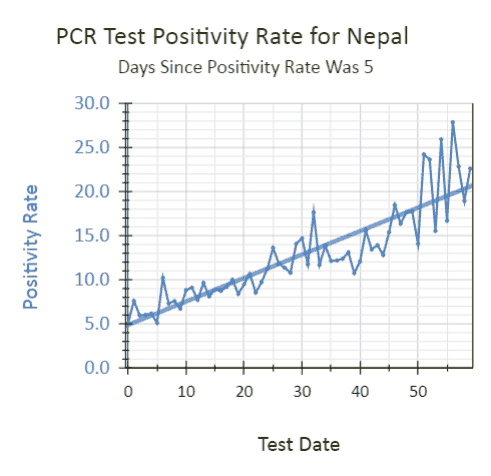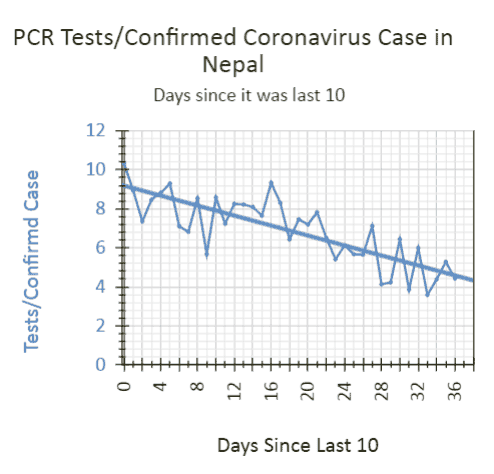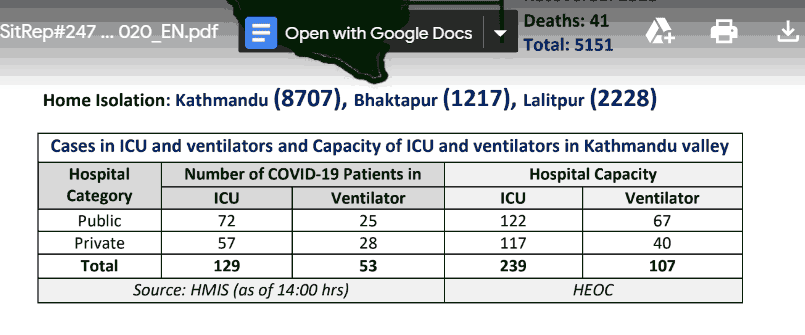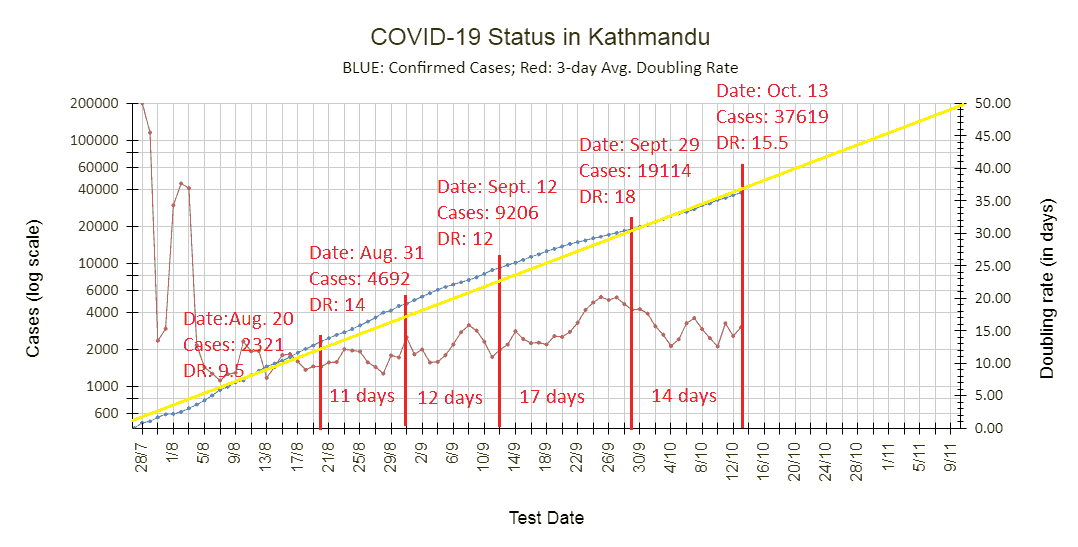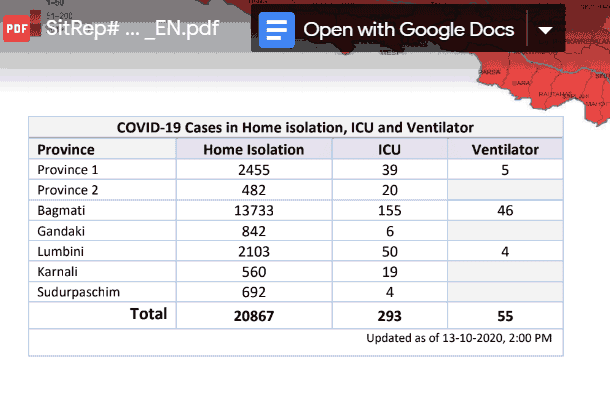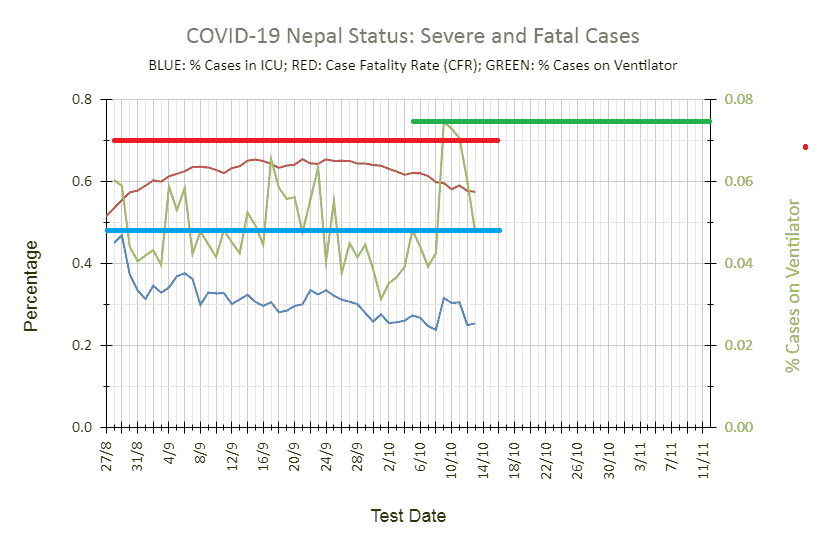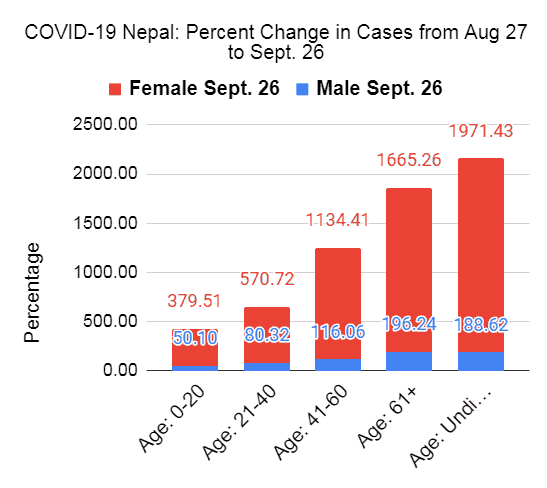We in Nepal are on our own now as far as our fight against the coronavirus pandemic is concerned.
After completely failing to contain the coronavirus and mitigate its spread, the Government of Nepal has given up on their pretenses of fighting the pandemic. The lockdown was lifted on July 22. Like clockwork, a week later — after average incubation period of the virus — the cases started growing exponentially (blue curve below, mostly covered by yellow line which, in addition to being an approximate best fit line, also show how the numbers might progress). (I’ll return to this chart later.)
That we are where we are to begin with, is a result of not having employed the tried and tested containment and mitigation strategy employed by countries that have successfully controlled the pandemic — lockdown, complemented by masstesting, isolating the infected, contacting tracing, and quarantining. That we had a second wave which we are currently in Stage 3 of — and hurling towards Stage 4 — is a result of that.
Following months of NOT having ANY strategy to speak of the government is now employing a “strategy” — of just letting the people deal with it.
I have a number of reasons for drawing that conclusion.
A Positivity Rate of 5% or less, according to WHO, indicates that the country has brought the pandemic under control. (Positivity Rate is the percentage of PCR tests that return a positive result. As such, if the testing were representative sample of the population, it provides an estimate for the prevalence of those infected in the population.)
The Positivity Rate has been climbing steadily (blue trendline in image below) for the past two month since the last time it was 5% (Aug. 17). Of late, Positivity Rates have been around 25%, five times the maximum, meaning we are far from controlling the pandemic! Additionally, that the prevalence of infected individuals in the population is just so high that the mitigation of the spread of the virus might not be possible.
PCR tests between 10 and 30 per confirmed positive result, according to WHO, indicates that the country is performing sufficient tests. In other words, that it’s identifying sufficient cases to help with the mitigation of the spread of the virus (if carried out diligently and properly). It’s been almost six weeks since the last time the number was 10 (Sept. 9), the minimum. Worse, it’s been decreasing steadily (blue trendline in image below), dropping even below 4!
That the patterns have been what they have been, to me, says that the government has stopped concerning itself with testing, and therefore with containment and mitigation the past two months.
Forget containment and mitigation, the government has decided to allow domestic flights to resume. Hotels and restaurants have been given the green light to open as well. Hotels have started advertising holiday packages for locals hoping to entice them to travel during the holidays.
Earlier this week, they lifted the restrictions on public transportation. We are only days before the biggest national holiday season of Dassain and Tihar. Nepalis will travel in the hundreds of thousands around the country as they head to their home villages etc. to be with families and celebrate.
The other reason for saying that we are on our own is, according to newspaper articles and TV programs, at least in Kathmandu, hospitals are already operating in “full capacity.”
A few days ago, on Oct. 13, in Kathmandu, 129 COVID-19 patients were in ICUs and 53 were hooked up to ventilators (see image below). Notice, occupancy, however is NOT 100%!
Here’s a table showing occupancy and capacity for some more days, the few limited days I found data for.
Note four things.
- their numbers haven’t changed much,
- ICU/ventilator occupancy/use stands at around 50% (ICU never exceeded 80%)
- percent confirmed cases in ICU is <0.5, &
- on ventilator is <0.2.
And, when it comes to ICUs and ventilators, one thing they show is that the hospitals have not be operating at full capacity!
Then why all the reports and discoveries by investigating journalists of “patients” being turned away? Hospitals are apparently REQUIRED to keep some on standby for VIPs…on their request (or demand?)!
.Here it is:
‘“We have to hoard ICU beds
because you never know when
you will get a call from a VIP
or a minister who wants someone
admitted,” says one doctor who
didn’t want to be named for this article.’#Nepal #COVID #COVID19 #COVID19Nepal https://t.co/UEstGlPWQr— Dorje Gurung, ScD (h.c.) (@Dorje_sDooing) October 12, 2020
The hospitals are full only for ordinary folks like you and I. It’s only for folks like you and I that the hospitals have no ICU beds or ventilators!
The situation with cases will only get worse, of course, the burden on the hospitals as well, as you can see in the graph below of daily cases in Kathmandu. As you can see, they are also growing exponentially as well.
The yellow line in the graph is an approximation of d trendline and therefore shows projection for d cases assuming everything else remains constant.
Notice 3-day Average Doubling Rates (DR) pretty much match actual rates! So, we are potentially looking at reaching 70K cases in about 15 days!
EVEN if the percentage of of those testing positive in Kathmandu requiring ICU beds and ventilators remain CONSTANT (~0.5 and ~0.2%) or even DECREASE by some miracle, the number of ICU beds and ventilators needed to serve them will rise by leaps & bounds!
Do they have plans to acquire more? The period for which I shared their data in the above table show small changes in their numbers. Will they acquire significantly more any time soon? If they do, they must come with personnel too, of course.
If you ask me, not likely!
What about at the national level?
I haven’t located the figures for their quantities by Province, but I’ll be really surprised if any have as many as Bagmati (or even just Kathmandu).
The table below shows their use also on Oct. 13 broken down by Province. Notice, Bagmati Province, where Kathmandu is, has d highest numbers. In other words, Kathmandu’s numbers are the highest.
Here a graph showing the pattern in their use nationally.
ICUs and ventilators have been serving no more than 0.5% (blue line) & 0.07% (green line) respectively of COVID-19 cases in d country.
But the cases — both in Kathmandu and at the national level — are growing exponentially, as has already been pointed out. Nationally, the 115K cases as of Oct. 13 is projected to double in about 25 days (see the graph at the very top). In Kathmandu, the 35K cases as of also Oct. 13 are projected to double in about 16 days.
In other words, cases needing ICU beds & ventilators WILL grow by leaps & bounds no doubt. If the hospitals in Kathmandu are already operating in “full capacity”, the health care system will be overwhelmed in little time.
That of course will drive the fatality rate (see red line the graph above), which has NOT exceeded 0.7% (7/1000), up and up!
Apart from exponential growth of cases overburdening the health case system in general, the number of the most vulnerable group (61+) — those more LIKELY to need ICU beds and/or ventilators — grew the most of all the age groups between Aug. 27 and Sept. 26 (see histogram below). The number of 61+ females grew by more then 17-fold! The number of 61+ males grew by almost 3-fold.
I bet that trend has continued and will continue for some time still.
A number of the recent decisions taken by the government — such as allowing businesses to open and lifting the restrictions on public transportation — will only add fuel to the exponentially growing fire of COVID-19 cases around the country. The pandemic is hurling toward Stage 4.
Stage 4 is characterized by “massive number of people start getting infected and the measures to contain the virus or control the number of affected patients seem almost impossible.”
Another indicator that we are on our own, that the government has washed their hands off of their responsibility to take the lead in tackling the pandemic is the disparaging manner they have been talking about the population. Officials have been openly expressing frustration over, blaming, or lamenting on, the population’s inability to make informed decisions (about which could be a whole blog post on its own)!
So, now that we have to fight this pandemic pretty much on our own, what can we do?
If Nepalis like you travel to their home village or city from wherever they are during this holiday season — as has always been the norm — many, many of them are likely to spread the virus to others, others in their family and potentially the community if they have already contracted it. If they are NOT a carrier, traveling in compact vehicles, or in vehicles filled to capacity, will increase their chances of being infected, and passing it on.
Want to prevent that? Don’t travel! Simple!! Miss Dassain and Tihar this year and survive, you’ll celebrate others to come in the future. Otherwise, you may end up NEVER celebrating one, or never with your elderly parents who — because you infected them — didn’t survive.
Or if you HAVE TO, if your life depended on it (!), travel in a partially filled vehicle with all the windows opened THE WHOLE TIME!
Apart from not travelling and NOT celebrating this holiday season, what else can you do? Avoid crowds. Wear a mask and wash your hands regularly.
If you can afford it, avail yourself of one of those services where they come and collect your swab at home for a PCR test if you want some — SOME — peace of mind. If you have to see a doctor, have them visit you at your home. PCR test is a good idea also because if you need or want a doctor to visit you at your home, they need proof of a negative result anyway.
And finally, again, if you can afford it, create a isolation unit in your home for anyone needing to isolate or quarantining themselves for whatever reason. Beside, over 50% of all active cases are being told to isolate at home anyway.
I realize that all that might be a little too much but there’s more! With winter approaching, the tendency will be for us to stay cooped up indoors with windows and doors shuttered. Plus, air pollution level also increases in the winter with the prevalent cool temperatures. Not to forget, the cold also makes us prone to flue and similar ailments, all of which will increase our chances of spreading and contracting COVID-19. We will have to be considerably more vigilant this winter.
What do you think?
(If interested in other blog posts about the status of COVID-19 in Nepal, click here, here, here, here, here, here, here, here, here, and here.)

